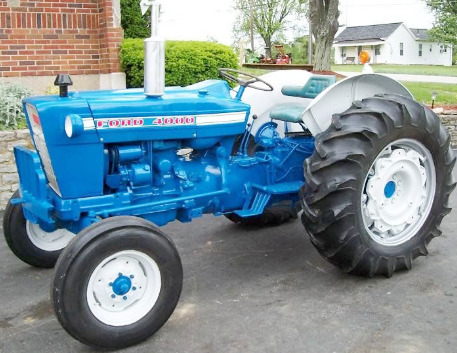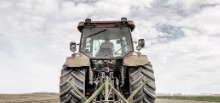________________________________________________________________________________________
Ford 4000 Tractor Troubleshooting
 The
Ford 4000 is a two-wheel drive utility tractor. This model was manufactured from
1962 to 1975. The Ford 4000 is powered by Ford vertical 3-cylinder naturally
aspirated cooled diesel engine with a maximum power of 46.7 hp (34.8 kW), or
Ford 3-cylinder water cooled gasoline engine with a maximum power of 46.3 hp
(34.5 kW).
The
Ford 4000 is a two-wheel drive utility tractor. This model was manufactured from
1962 to 1975. The Ford 4000 is powered by Ford vertical 3-cylinder naturally
aspirated cooled diesel engine with a maximum power of 46.7 hp (34.8 kW), or
Ford 3-cylinder water cooled gasoline engine with a maximum power of 46.3 hp
(34.5 kW).
The Ford 4000 tractor was fitted with 2 types of transmission. 1st type:
8x2 Dual-Range transmission. 2nd type: Select-O-Speed transmission with
10 forward and 2 reverse gears.
Max. travel speed (forward/reverse): 17.6 mph (28.3 km/h) and 8.1 mph
(13 km/h). The open center hydraulic system used a gear pump with a
rated fluid flow of 5 gpm (18.9 lpm) or 5.5 gpm (20.8 lpm). The main
relief pressure is 173 bar (2500 psi). The tractor is equipped with
6.0x16 or 7.5x16 front tyres and 12.4x38 or 13.6x38 rear tyres. The
wheel base is 84.5" (2140 mm). The Ford 4000 is compatible with a
Ford
771 loader with lift capacity to full height of 1800 lbs (816 kg), or
Ford 772 loader with lift capacity to full height of 2500 lbs (1134 kg).
| Diesel Engine Troubleshooting |
| Engine doesn't start or difficult to start |
| Clogged fuel filter element - Clean or change the filter |
| Fuel shut-off valve closed - Open the fuel shut-off valve |
| Air in fuel lines - Bleed fuel lines |
| Dirty or damaged injectors - Test fuel injectors and change if necessary |
| Fuel injection pump malfunction - Repair or replace injection pump |
| Poor compression - Inspect and replace faulty parts |
| Diesel shuts off during operation |
| Low coolant temperature - Warm up the engine |
| Air in fuel system - Air-bleed fuel system |
| Fuel injection failed - Use correct settings |
| Fuel filter clogging - Change filter element |
| Clogged fuel injectors - Inspect fuel injectors and replace if necessary |
| Diesel starts and immediately stops |
| Timing of fuel injection pump is not adjusted - Adjust injection timing |
| Fuel filter is clogged - Clean the filter or install new filter element |
| Fuel injector nozzles are dirty - Change or clean injector nozzles |
| Fuel injection pump damage - Rebuild or replace pump |
| Air cleaner element clogging - Change or service air cleaner element |
| Engine stops while idling |
| Too low idle RPM - Adjust the low idle speed |
| Fuel injection pump is defective - Change pump or rebuild it |
| Fuel injector nozzles are damaged or dirty - Service or replace nozzles if required |
| Excessive valve clearance - Adjustment procedure required |
| Insufficient coolant - Top up coolant fluid. Check system for leaks |
| Cooling system components are worn or system is clogged - Flush cooling system or change faulty components |
| Engine oil level low - Checking oil level and add if necessary |
| Fan belt tension is improper or belt is defective - Adjust as required or replace belt |
| Thermostat failure - Replace the thermostat |
| Dirty or damaged injectors - Test fuel injectors and change if necessary |
| Insufficient fuel injection pressure - Adjust to correct pressure |
| Clogged air filter element - Install new filter element or replace it |
| Dirty oil filter - Clean or change engine oil filter |
| Engine overloaded - Change to lower gear or reduce load |
| Valve out of adjustment - Check and adjust |
| Wrong adjustment of low idle speed - Test and adjust |
| Fuel pipes or hoses clogging - Clean fuel system pipes and hoses |
| Engine compression is low: Valves are broken or leaking - Replace the valves |
| Incorrect setting of fuel injection pump timing - Check and correct adjustments |
| Fuel injector nozzles are damaged - Change injector nozzles |
| Insufficient engine oil - Fill up the engine oil |
| Engine not warmed up - Warm up the engine |
| Main bearings or crankshaft wear - Install new parts |
| Piston rings failure - Piston rings need to be replaced |
| Loose flywheel bolts - Inspect flywheel bolts and tighten properly |
| Oil leaking: Damaged seals or gaskets - Replace defective parts |
| Oil viscosity is wrong - Use oil of correct viscosity |
| Piston rings are seized or worn - Piston rings replacement required |
| Valve stems or guides are damaged - Valves must be replaced |
| Worn cylinder liners or pistons - Check pistons and liners, change as required |
| Electrical System Troubleshooting |
| Battery will not charge |
| Battery faulty cell - Replace the battery |
| Damaged battery wiring harness - Inspect wiring for damage, replace or repair |
| Corroded or loose battery cables and terminals - Tighten or clean cables and terminals |
| Defective belt or improperly adjusted belt tension - Install new belt or adjust belt tension as required |
| Low battery capacity - Battery is drained, charge it |
| Battery drains quickly - Service or change the battery |
| Battery wiring harness damage - Inspect battery wiring for damage, replace or repair |
| Corroded or loose terminals and cables - Terminals and cables need to be tightened or cleaned |
| Battery voltage is low - Recharge the battery |
| Discharged or faulty battery - Charge or change the battery |
| Starter motor is damaged - Change or repair starter |
| Disconnected or incorrectly connected cables - Inspect battery cables and connect correctly |
| Transmission Troubleshooting |
| Hard shifts |
| Misadjusted or defective clutch - Adjust clutch or change if necessary |
| Gear shift linkage is damaged or loose - Change defective shift linkage |
| Worn or damaged shift forks - Shift forks need to be changed |
| Faulty parts in the gear shifting mechanism - Change faulty parts |
| Insufficient transmission fluid pressure |
| Fluid level is low - Add transmission fluid as required |
| Transmission fluid filter clogging (if fitted) - Change or service the transmission fluid filter |
| Relief valve failure - Replace valve as required |
| Bearings are worn or cracked - Faulty bearings should be replaced |
| Insufficient fluid supply - Fill system with correct transmission fluid level |
| Transmission fluid contamination - Change transmission fluid |
| Gears are defective or backlash is incorrect - Set backlash correctly or change the gears |
| Damaged or worn shift forks - Change defective shift forks |
| Worn gaskets or seals - Install new gaskets or seal |
| Transmission case is cracked - Replace case or transmission assembly |
| Hydraulics Troubleshooting |
| Hydraulic system overheating |
| Hydraulic system pressure is not adjusted correctly - Correct adjustment is required |
| Main relief valve malfunction or incorrect adjustment - Adjust or replace the relief valve |
| Hydraulic oil is dirty - Hydraulic oil change required |
| Air in hydraulic system - Check the suction pipe, fittings, and pump seals |
| Insufficient hydraulic oil pressure |
| Hydraulic fluid level is insufficient - Add fluid to the hydraulic system |
| Hydraulic oil filter element clogging - Hydraulic filter maintenance required |
| Hydraulic pump is faulty - Test pump performance and replace pump if necessary |
| Damaged or incorrect adjusted hydraulic spool valve - Set properly or replace |
| Faulty hydraulic cylinder - Check cylinder components for wear or damage and change if necessary |
| Leakage in hydraulic lines - Identify leaks in the system and repair it |
| 3-point hitch does not raise or raises very slowly |
| Hydraulic fluid level is insufficient - Fill the hydraulic system with oil |
| Cold hydraulic oil - Warm up the oil |
| Hydraulic oil filter is dirty - Hydraulic filter maintenance required |
| Defective hydraulic pump - Check the pump performance and replace it if required |
| Main relief valve incorrect adjustment or failure - Replace or set up the relief valve |
| Hydraulic spool valve block is not set properly or defective - Adjust properly or change |
| Hydraulic cylinder is broken - Check cylinder components for wear or damage and change if necessary |
| Suction line is damaged or disconnected - Connect or replace |
| Three-point hitch dropping is too slow or cannot be dropped |
| Hydraulic control valve is defective or set improper - Replace or adjust correctly |
| Defective hydraulic cylinder - Inspect the hydraulic cylinder parts for damage or wear and replace if required |
| Damaged lift arm shaft - Replace the shaft |
| The hitch has any internal mechanical damage - Change worn or damaged hitch components |
| Hitch jerks when lower or lift |
| Hydraulic system sucks air - Check the suction pipe, fittings, and pump seals |
| Hydraulic oil is dirty - Hydraulic oil change required |
| Hydraulic pump is defective - Check pump flow and install new pump if necessary |
| Hydraulic spool valve block is faulty or out of adjustment - Adjust correctly or change |
| Hydraulic cylinder is faulty - Inspect cylinder components for wear or damage and change if required |
| Steering System Troubleshooting |
| Hard Steering |
| Steering knuckle or steering column is stuck - Inspect steering column and knuckle, replace worn parts as required |
| Steering gearbox components are worn - Replace defective components of steering gearbox |
| Faulty drag link or tie rod - Replace or repair |
| Insufficient lubrication in steering box - Need to lubricate the gearbox |
| Not adjusted toe-in alignment - Check and adjust toe-in |
| Tires are not correctly inflated - Inflate tires as necessary |
| Excessive steering wheel free play |
| Steering column bearing or shaft is worn - Change faulty parts |
| Steering linkage assembly is worn or loose - Repair or replace steering linkage |
| Worn steering gearbox bearings - Replace the bearings |
| Front wheel hub bearings or steering knuckles are worn - Change hub bearings or knuckles |
| Damaged or worn steering tie-rod ends - Change faulty part |
| Tractor pulls to right or left |
| Worn or loose steering linkage assembly - Repair or replace steering linkage |
| Defective steering knuckle bushing - Replace knuckle bushing |
| Uneven tire pressure - Inflate the tires properly |
| Toe-in adjustment is incorrect - Adjust toe-in correctly |
________________________________________________________________________________________
________________________________________________________________________________________
________________________________________________________________________________________
| Farm Tractors Technical Specifications |
 The
Ford 4000 is a two-wheel drive utility tractor. This model was manufactured from
1962 to 1975. The Ford 4000 is powered by Ford vertical 3-cylinder naturally
aspirated cooled diesel engine with a maximum power of 46.7 hp (34.8 kW), or
Ford 3-cylinder water cooled gasoline engine with a maximum power of 46.3 hp
(34.5 kW).
The
Ford 4000 is a two-wheel drive utility tractor. This model was manufactured from
1962 to 1975. The Ford 4000 is powered by Ford vertical 3-cylinder naturally
aspirated cooled diesel engine with a maximum power of 46.7 hp (34.8 kW), or
Ford 3-cylinder water cooled gasoline engine with a maximum power of 46.3 hp
(34.5 kW).